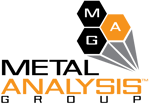EXPERT-APPROVED: OES ALLOY
Expert-Approved OES Analyzers for Scrap Recycling from Metal Analysis Group
The metals recycling industry is experiencing rapid growth due to increasing demand for metals and the challenges associated with mining new materials. This surge is driving the recycling markets for aluminum, copper, and steel, with aluminum and steel expected to grow at a CAGR of around 8% and copper by 4% over the next four years.
For recycling facilities, this growth presents both opportunities and challenges. To manage the increasing volume of scrap material efficiently, advanced analytical equipment is essential. Metal Analysis Group latest optical emission spectrometers offer the accuracy, speed, and affordability necessary for modern recycling yards. These instruments address the main challenges faced by scrapyards and high-end recycling facilities:
Handling Large Scrap Turnover
Large recycling facilities often deal with tens of thousands of tons of ferrous and non-ferrous scrap weekly. Rapid sorting and precise composition verification of each scrap piece are crucial to keep up with the incoming volumes. OES instruments provide the fast analysis needed, taking only seconds for each assessment. Additionally, their design includes quick start-up times to minimize downtime at the start of shifts.
Accurate Composition Identification
Traditionally, handheld XRF analyzers have been used for sorting scrap metals. However, with increasing demand in the foundry sector, OES technology has become essential to ensure recycled metals meet stringent specifications for melt feedstocks. The OES instruments use advanced CMOS detector technology and a LightWing (patent pending) optic design, allowing detection of all elements within metals at the ppm range, crucial for today's industry standards.
Compliance with Regulations
Quality assurance of recycled metals is critical, but recycling facilities also face numerous regulations related to environmental impact, safety, radioactivity, and transportation. The OES series ensures reliable and retrievable analysis results.
Effective recycling requires the ability to analyze tramp and trace elements in various base metals. The OES instruments can identify key elements in copper, aluminum, and steel matrices. For example, the OES instruments can determine low limits of phosphorus in aluminum-silicon alloys and analyze nitrogen in steel, hydrogen and oxygen in titanium, and oxygen in copper.
Cost-Effectiveness
The OES covers the entire spectrum of non-gaseous elements in metals, while the OES instruments adds gas analysis capabilities. These instruments incorporate cutting-edge technology comparable to more expensive analyzers, making high-quality analysis accessible to many recycling facilities. Designed for low running costs, they feature reduced argon and power consumption compared to previous models.
Understanding OES Technology
Optical emission spectrometry (OES) determines the composition of metals by analyzing the light emitted when the metal's atoms are excited. Different metals produce unique colors, sizes, and appearances of sparks, which are used to identify their composition. The OES instruments use this principle to provide fast, accurate analysis critical for efficient metals recycling operations.
In summary, Metal Analysis Group's OES instruments bring advanced, cost-effective analysis capabilities to the metals recycling industry, helping facilities manage large scrap volumes, meet stringent regulatory requirements, and ensure the quality of recycled metals.
